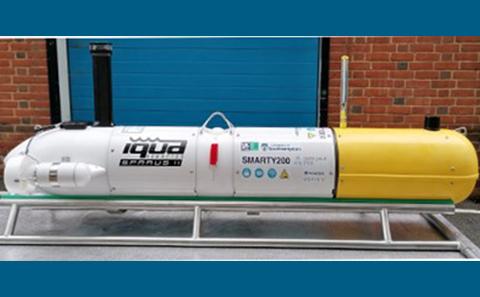Autonomous Underwater Vehicle SMARTY200

The University of Southampton (UoS) has acquired the ‘SMARTY200’ Autonomous Underwater Vehicle (AUV) to develop intelligent subsea mapping capabilities as part of a EPSRC core equipment grant. Researchers from the UoS IRIS Centre of Excellence (CoE), SMMI and IROE are working together with industry partners at IQUA robotics, Sonardyne and Voyis to implement novel camera-mapping, underwater positioning, and machine learning capabilities on the AUV. The platform is the focus of knowledge transfer partnerships, funded by SMMI HEIF and the Southampton Geospatial initiative, to commercialise UoS data processing methods and apply the SMARTY200 to conservation in Studland Bay.
Seagrass monitoring surveys are planned to take place in July 2022, with UoS researchers from across Engineering, Geography and Ocean and Earth Science working together with the Studland Bay Marine Partnership including the National Trust and Dorset Coast Forum. The partnership involves local conservation organisations, boat users and local community groups, who are working together to protect the seagrass by installing ‘eco-moorings’ within the bay. These mooring are designed to reduce boat anchor damage and so allow the seagrass and local biodiversity to thrive, while maintaining the vibrant sailing and recreational activities within the bay. Currently there are 10 eco-moorings installed with future plans to extend this to 100.
Surveys with SMARTY200 aim to map the extent and distribution of seagrass in the Studland Bay Marine Conservation Zone. This will allow scientists to build a more comprehensive understanding of seagrass health around the eco-moorings and monitor seagrass recovery from past anchor damage.
The team hopes this will be just the start of a sustained series of projects leveraging the unique capabilities SMARTY200 and other IRIS robotic platforms have to offer. Professor Blair Thornton, IRIS CoE co-director and SMMI expert says:
‘Robotics and AI technologies are key enablers to help scientists build big picture understanding of natural and built environments. We are interested in addressing real-world challenges in conservation and infrastructure inspection. Our team is currently working closely with local communities and those much further afield to understand their challenges, and figure out the best way to contribute to conservation and monitoring by using and adapting our technology’
More information about SMARTY200 can be found on the IRIS and ocean perception websites. Read more about the Studland Bay monitoring initiative at the BBC and news articles here and here.